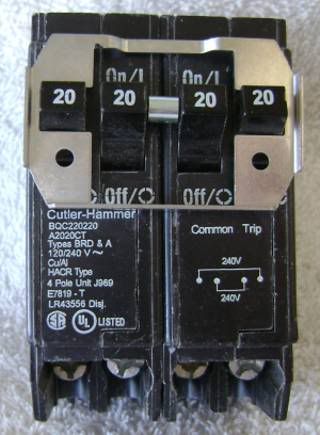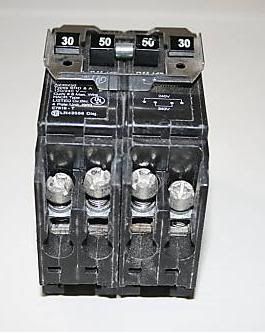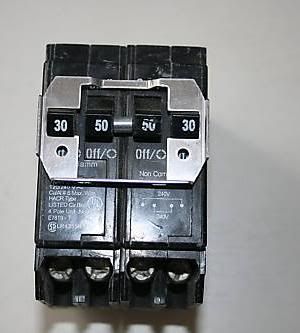I hope someone can help me understand what I?m looking at. Please refer to the partial picture of a main residential panel below. I have not taken the panel cover off (yet) to see what the OCPDs in question look like from the rear.
Look at the top two breakers. Each appears to be a double pole breaker and each breaker has one 20A and one 40A breaker in the same housing. Both the water heater and the range are 240V appliances and each is served by the two corresponding halves of each of the breakers. Both breakers have handle ties, the inside 40A ones for the range (one pole from each breaker) are linked with looks like a more or less conventional handle tie, and the outside 20A ones (again, one pole from each breaker) for the water heater are linked with what I think is a made tie. It may not be but I haven?t seen this before.
My question is why would this system be used instead of the more conventional way, one double-pole 20A and one double pole 40A breaker? Why would one even use a double pole breaker with different A ratings for each of the poles? I didn?t even know such beasties were manufactured.
I?m sorry folks but my ignorance is vast and I hope for some enlightenment.
Heinz R.
Look at the top two breakers. Each appears to be a double pole breaker and each breaker has one 20A and one 40A breaker in the same housing. Both the water heater and the range are 240V appliances and each is served by the two corresponding halves of each of the breakers. Both breakers have handle ties, the inside 40A ones for the range (one pole from each breaker) are linked with looks like a more or less conventional handle tie, and the outside 20A ones (again, one pole from each breaker) for the water heater are linked with what I think is a made tie. It may not be but I haven?t seen this before.
My question is why would this system be used instead of the more conventional way, one double-pole 20A and one double pole 40A breaker? Why would one even use a double pole breaker with different A ratings for each of the poles? I didn?t even know such beasties were manufactured.
I?m sorry folks but my ignorance is vast and I hope for some enlightenment.
Heinz R.






